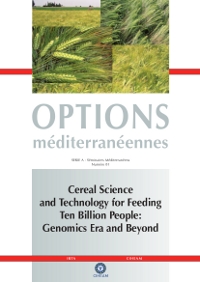| Article précédent | p. 179-182 | Article suivant |
Fusarium head blight evaluation in wheat transgenic plants expressing the maize B-32 antifungal gene
The introduction and expression of some of defence genes have been shown to confer increased resistance to plant fungal pathogens. A class of plant proteins, known as RIPs (Ribosome-Inactivating Proteins), also display antifungal properties; RIPs are specific N-glycosidases that inactivate the ribosome and block translation elongation by removing an adenine residue from the highly conserved stem-loop structure (SRL) in the large rRNA, which interacts with the elongation factors during protein synthesis. Barley and maize contain RIPs in their grain endosperm - respectively RIP30 and b-32 - that are weakly active or inactive against the producing cell's ribosomes, but which are active against alien eukaryotic ribosomes, such as the ones of pathogenic fungi. The maize b-32 defence properties against various biotic agents have been evaluated: antifungal activity was demonstrated in vitro and in vivo and its relative toxicity to insects has been proven. In order to further explore the antifungal activity of the maize b-32, six homozygous wheat lines were obtained via biolistic transformation, in which the b-32 gene was driven by the 35SCaMV promoter in association to the bar gene as a selectable marker; plants were raised and brought to homozygosity through genetic analysis of progeny. In this study the six wheat transgenic lines and the parental cv. Veery were challenged for response against Fusarium culmorum, in order to detect the potential protective role of b-32 against fungal diseases.
- [ Afficher ]
- [ Télécharger ]
- [ Exporter la citation ]
Vous pouvez télécharger la citation au format :
- [ Imprimer ]
-
Mots-clés
BLE, FUSARIUM, MAIS, PLANTE TRANSGENIQUE, RESISTANCE AUX MALADIES, RESISTANCE GENETIQUE, RIBOSOME, TRITICUM, ZEA MAYSCiter cet article
Balconi C., Lanzanova C., Conti E., Triulzi T., Forlani F., Cattaneo M., Lupotto E. Fusarium head blight evaluation in wheat transgenic plants expressing the maize B-32 antifungal gene. In : Molina-Cano J.L. (ed.), Christou P. (ed.), Graner A. (ed.), Hammer K. (ed.), Jouve N. (ed.), Keller B. (ed.), Lasa J.M. (ed.), Powell W. (ed.), Royo C. (ed.), Shewry P. (ed.), Stanca A.M. (ed.). Cereal science and technology for feeding ten billion people: genomics era and beyond. Zaragoza : CIHEAM / IRTA, 2008. p. 179-182. (Options Méditerranéennes : Série A. Séminaires Méditerranéens; n. 81). Meeting of the Eucarpia Cereal Section, 2006/11/13-17, Lleida (Spain). http://om.ciheam.org/om/pdf/a81/00800834.pdf



